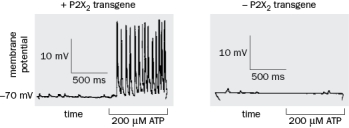Multiple Choice
In the experiment in Figure , the motor neuron of a muscle expressed the P2X2 transgene and the response in the muscle was recorded. Why did application of ATP activate the muscle?  Figure
Figure
A) Addition of ATP activated of the P2X2 channel which directly increased transmitter release by moving vesicles to the presynaptic membrane.
B) Addition of ATP resulted in opening of the P2X2 channel and an influx of sodium, which activated the motor neuron, releasing neurotransmitter and activation of the muscle.
C) Addition of the resulted in activation of the P2X2 protein, a G protein coupled receptor. Once activated the receptor increased the probability of neurotransmitter release and activated the muscle.
D) Addition of ATP resulted in activation of the ATP receptor, a G protein coupled receptor. Once activated, this G protein indirectly activated P2X2, which increased the probability of neurotransmitter release from the motor neuron and activated the muscle.
Correct Answer:

Verified
Correct Answer:
Verified
Q17: You are recording from some neurons in
Q18: You want to determine which genes are
Q19: Using any vertebrate animal in research is
Q20: What is the advantage of an intracellular
Q21: How does ChR2 activate neurons?<br>A) Blue light
Q23: What is one of the potential advantages
Q24: Trans-synaptic tracing uses rabies virus to spread
Q25: What is the difference between a knock-in
Q26: Deep brain stimulation is a technique used
Q27: An important principle in neuroethology is to